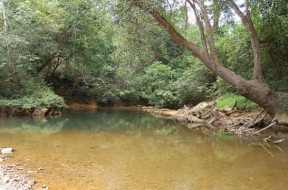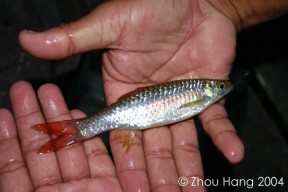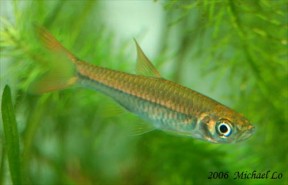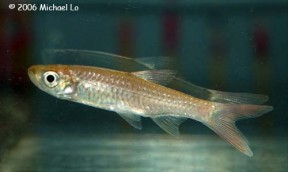Rasbora tornieri
Etymology
tornieri: named for German zoologist and paleontologist Gustav Tornier.
Classification
Order: Cypriniformes Family: Cyprinidae
Distribution
Type locality is ‘Central Sumatra, Indonesia’, with additional records existing from Cambodia (Mekong drainage), Peninsular Malaysia (Perak River), Sumatra (from the Siak River, Riau province to the Musi River, South Sumatra (Sumatera Selatan) province) and Borneo (south and westwards from the Belait river basin in Brunei Darussalam to the Sambas drainage in West Kalimantan (Kalimantan Barat) province, Indonesia and probably in Sarawak, Malaysia).
Habitat
Has been collected from various habitat-types including flowing streams and more sluggish blackwaters associated with areas of ancient peat swamp forest which are typically full of fallen leaves, twigs and branches.
In the former the water tends to be relatively transparent with a more-or-less neutral pH whereas in the latter it’s characteristically stained brown due to the release of tannins and other chemicals released by decomposing organic material, of negligible hardness and conductivity, and acidic (pH 3.0 – 6.0).
It also inhabits permanent bodies of water including pools, backwaters and reservoirs and is known to move into flooded areas during the wet season across some of its range.
In the Musi river, Sumatra, R. tornieri occurs sympatrically with the similar-looking congener R. dusonensis (see ‘Notes’).
Maximum Standard Length
80 – 90 mm.
Aquarium SizeTop ↑
Requires a relatively large aquarium with a minimum surface area of 120 ∗ 30 cm or equivalent.
Maintenance
Choice of décor is not as critical as water quality and the amount of open swimming-space provided.
It will fare equally well in a heavily-planted aquarium or set-up designed to resemble a flowing river with a substrate of variably-sized rocks and gravel, some large water-worn boulders and moderate water movement.
The latter could be further furnished with some driftwood roots and branches plus some hardy aquatic plants.
In either situation a tightly-fitting cover is essential as this species may jump at times.
It’s also intolerant to the accumulation of organic wastes and requires spotless water at all times in order to thrive meaning a stringent maintenance regime is essential.
Water Conditions
Temperature: 20 – 26 °C
pH: 4.0 – 7.0
Hardness: 18 – 179 ppm
Diet
Likely to feed on aquatic and terrestrial invertebrates in nature.
In the aquarium it will accept dried foods of a suitable size but should not be fed these on an exclusive basis.
Daily meals of small live and frozen fare such as Daphnia, Artemia and suchlike will result in the best colouration and encourage the fish to come into breeding condition.
Behaviour and CompatibilityTop ↑
This species is peaceful making it an ideal resident of the well-chosen community aquarium, although as always when selecting compatible fishes proper research is essential and its adult size should be a consideration.
A community based around one of its native countries or river basins could make a worthwhile project with some interesting alternatives.
It’s a schooling species by nature and ideally a group of at least 6 specimens should be purchased.
Maintaining it in decent numbers will not only make the fish less nervous but will result in a more effective, natural-looking display, while males will display some interesting behaviour as they compete with one other for female attention.
Sexual Dimorphism
Mature females are noticeably rounder-bellied and often a little larger than males.
Reproduction
May not yet have been bred in aquaria although likely to exhibit an egg-scattering strategy with no parental care.
When the fish are in good condition they will spawn often and in a well-decorated, mature aquarium it’s possible that small numbers of fry may start to appear without human intervention.
However if you want to increase the yield of fry a slightly more controlled approach is required for which several different methods have proven successful for congeners.
What is essential is to provide some sort of egg trap or barrier through which the eggs can pass in order to prevent the adults eating them.
Incubation in Rasbora eggs is temperature-dependant to an extent but usually takes between 18 and 48 hours with the young free-swimming 24 to 48 hours later.
Microscopic food such as Paramecium may be required initially, introducing Artemia nauplii, microworm, etc., once the fry are large enough to accept them.
NotesTop ↑
The identity of this species was unclear for a number of decades prior to its redescription by Ng and Kottelat (2013).
The confusion originated with Brittan (1954) who misidentified specimens of R. tornieri as R. dusonensis and synonymised it with R. cephalotaenia before it was revalidated by Kottelat (1991) who also designated a lectotype.
R. tornieri is very similar to R. dusonensis and these two can be distinguished from other members of the genus by the following combination of characters: a broad, dark brown, sharply-defined midlateral body stripe extending from the opercle to the caudal-fin base; a dark brown supralateral stripe and dorsum separated from the midlateral stripe by a light longitudinal area; 12–14 predorsal scales; dorsohypural distance equal to or slightly less than the distance between the dorsal-fin origin and posterior orbital margin; 14 circumpeduncular scales; caudal-fin brightly coloured in life.
R. tornieri differs from R. dusonensis in possessing a carmine red (vs. bright yellow in R. dusonensis) caudal-fin with or without a narrow dark margin (vs. always with a broad, dark distal margin), and a deeper caudal peduncle fitting 7.9-8.8 times in SL and measuring 11.4-12.6 % SL (vs. 8.5–9.6 times and 10.4–11.7 % SL, respectively).
Both R. tornieri and R. dusonensis are included in the R. argyrotaenia species group (sensu Brittan, 1954, see below) of which members share the following characters: 14 circumpeduncular scale rows, the dorsohypural distance equal to or slightly less than the distance between the dorsal-fin origin and posterior orbital margin, 1 or 1½ scale rows between the lateral line and the origin of the pelvic-fin, and a continuous dark midlateral stripe from the opercle to the base of the caudal-fin.
The identity of R. argyrotaenia itself is uncertain though with the type series consisting of fish from several localities and possibly comprising multiple taxa.
As currently recognised it occurs in Java (the type locality), Sumatra, Borneo and the Malay Peninsula but this distribution represents an assemblage which will eventually be split into several species (Kottelat, 2012).
Rasbora is among the more speciose genera in the family Cyprinidae with members distributed throughout much of Southeast Asia.
The last major review of the genus was published by Brittan (1954) in which the species were arranged into eight groups (referred to as ‘species complexes’ by the author) and it has long been recognised as a ‘catch-all’ polyphyletic grouping because no synapomorphy has been proposed to diagnose it.
Brittan diagnosed the genus by the following combination of characters: presence of a symphyseal knob on the lower jaw; three pharyngeal tooth rows; one or two scales between the lateral-line scale row and pelvic-fin insertion; dorsal-fin insertion opposite to pelvic-fin insertion or slightly behind it; seven branched dorsal-fin rays and five branched anal-fin rays; absence of barbels.
A number of former members of Rasbora sensu Brittan have been placed in new genera by various authors, these including Rasboroides, Boraras, Trigonostigma and Sundadanio.
More recently Liao et al. (2010) conducted a morphological phylogenetic analysis of Rasbora and related genera with six clades (A-F) recognised in their results.
They erected four new genera, all containing former members of Rasbora, in order to preserve monophyly of Boraras, Horadandia, Rasbora, Rasboroides and Trigonostigma.
Clades A and B were monotypic with the species formerly known as R. brittani reclassified as Kottelatia brittani and R. dorsiocellata as Brevibora dorsiocellata, respectively (Brevibora currently contains two species).
Clade C comprised the genera Boraras, Horadandia, Rasboroides and Trigonostigma plus three species previously included in Rasbora which were moved into the new genera Trigonopoma (containing T. gracile and T. pauciperforatum) and Rasbosoma (containing R. spilocerca).
The results for Boraras and Trigonostigma were found to be inconclusive in some respects and further work regarding their phylogenetic position was recommended.
Clade D included Rasbora semilineata, R. borapetensis, R. rubrodorsalis and an undescribed fish similar to R. beauforti while clade E consisted of R. daniconius, R. hubbsi, R. paucisqualis, R. wilpita, R. kobonensis, R. ornata and R. cf. daniconius.
Clade F was subdivided into two groupings, the first containing R. einthovenii, R. elegans and R. cephalotaenia and the second R. lateristriata, R. argyrotaenia, R. volzii, R. paviana, R. rasbora (plus an undescribed, similar fish), R. caudimaculata and R. trilineata.
As this final clade contains the type species (see below) its members retained the generic name Rasbora as did those included in clade E because they weren’t considered to differ sufficiently to warrant a the erection of a new grouping.
Many Rasbora species weren’t included in the study however so the authors proposed an arrangement comprising six species groups, namely the R. semilineata, R. trifasciata, R. daniconius, R. einthovenii, R. argyrotaenia and R. sumatrana groups, plus a number of species which were not included in any group.
Shortly afterwards a paper investigating systematics of the subfamily Danioninae was published by Tang et al. (2010) and their conclusions differed significantly, however.
The four new genera proposed by Liao et al. were synonymised with Rasbora as were Boraras and Trigonostigma since their phylogenetic placement would otherwise have rendered Rasbora polyphyletic and require that it be broken up into many different genera.
Although such actions may turn out to be justified, with the monophyly of Boraras and Trigonostigma strongly supported, a revision of the entire genus Rasbora would be required which was beyond the scope of the authors’ study.
This more conservative approach to the group’s taxonomy was therefore adopted although this will probably be subject to considerable change as additional studies are published.
Here on SF we’ve chosen to retain the system proposed by Liao et al. (2010) for the time being since generic names such as Boraras and Trigonostigma are well-established in aquarium literature and appear likely to be revalidated in the future.
The identity of the type species, often given as R. rasbora in the past, is no longer in question.
When Bleeker first referred to the name Rasbora in 1859 only four nominal members were included of which R. cephalotaenia (known as Leuciscus cephalotaenia at the time) should be considered the type.
References
- Brittan, M. R., 1972 - T. F. H. Publications: 1-224
Rasbora: a revision of the Indo-Malayan fresh-water fish genus Rasbora. - Kottelat, M., 1999 - Raffles Bulletin of Zoology 47(2): 591-600
Nomenclature of the genera Barbodes, Cyclocheilichthys, Rasbora and Chonerhinos (Teleostei: Cyprinidae and Tetraodontidae), with comments on the definition of the first reviser. - Kottelat, M., 1991 - Ichthyological Exploration of Freshwaters 2(2): 177-191
Notes on the taxonomy of some Sundaic and Indochinese species of Rasbora, with description of four new species (Pisces: Cyprinidae). - Kottelat, M., 2012 - Revue suisse de Zoologie 119(1): 77-87
Rasbora rheophila, a new species of fish from northern Borneo (Teleostei: Cyprinidae). - Liao, T. Y., S. O. Kullander and F. Fang, 2010 - Zoologica Scripta 39(2): 155-176
Phylogenetic analysis of the genus Rasbora (Teleostei: Cyprinidae). - Mayden, R. L., K. L. Tang, K. W. Conway, J. Freyhof, S. Chamberlain, M. Haskins, L. Schneider, M. Sudkamp, R. M. Wood, M. Agnew, A. Bufalino, Z. Sulaiman, M. Miya, K. Saitoh and S. He, 2007 - Journal of Experimental Zoology, Molecular Development and Evolution 308B: 1-13
Phylogenetic relationships of Danio within the order Cypriniformes: a framework for comparative and evolutionary studies of a model species. - Ng, H. H. and M. Kottelat, 2013 - Zootaxa 3635(1): 62-70
The identity of the cyprinid fishes Rasbora dusonensis and R. tornieri (Teleostei: Cyprinidae). - Rainboth, W. J., 1996 - FAO, Rome: 1-265
Fishes of the Cambodian Mekong. FAO Species Identification Field Guide for Fishery Purposes. - Tang, K. L., M. K. Agnew, W. J. Chen., M. V. Hirt, T. Sado, L. M. Schneider, J. Freyhof, Z. Sulaiman, E. Swartz, C. Vidthayanon, M. Miya, K. Saitoh, A. M. Simons, R. M. Wood and R. L. Mayden, 2010 - Molecular Phylogenetics and Evolution 57(1): 189-214
Systematics of the subfamily Danioninae (Teleostei: Cypriniformes: Cyprinidae).






